child seat VOLKSWAGEN GOLF 2005 User Guide
[x] Cancel search | Manufacturer: VOLKSWAGEN, Model Year: 2005, Model line: GOLF, Model: VOLKSWAGEN GOLF 2005Pages: 444, PDF Size: 92.7 MB
Page 101 of 444
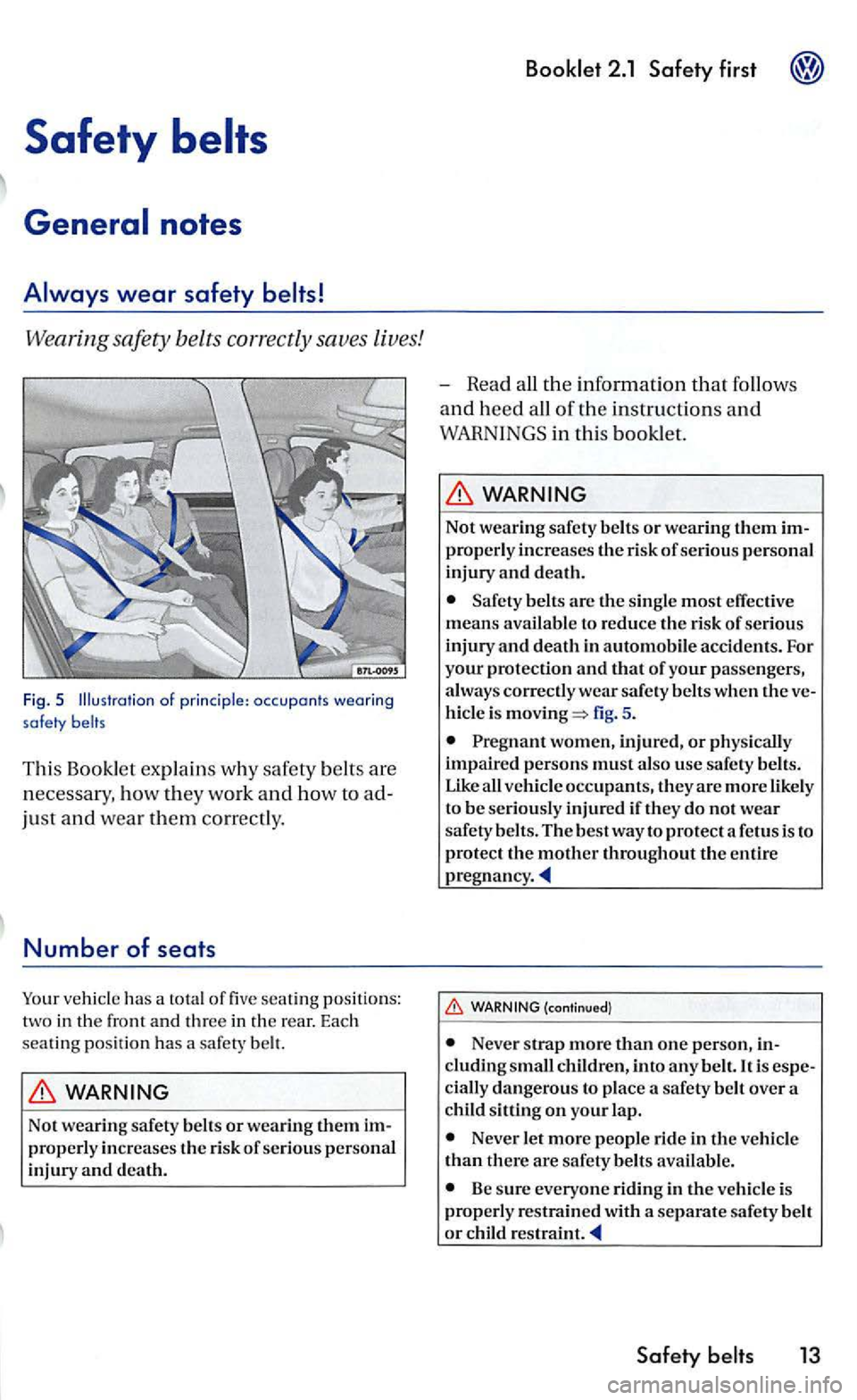
Safety
wear safety
Wearing safety belts correctly saves lives!
Fig. 5 of principle: occu pants wearing safety belts
This Booklet expla in s w hy safety belt s are
necessa ry . how they work and how to
just and wear them correctly .
Number of seats
Your vehicl e has a total of five se ating position s:
two in t h e fron t and three in th e re ar. Eac h seating positio n has a sa fe ty belt.
WARNING
Not wearin g safety belts or wea ring them
- Read all the information that follows
and heed all of the instructio ns and
WARNINGS in thi s bookl et.
WARNING
No t wearing safety belt s o r wearing them properly increases the ris k of se rious pe rson al
injury and death.
Safety belts are th e s ingle most effective
means availa ble to reduce the risk of serious inju ry and death in automobile acciden ts . For your protection and that of your passengers,
a lways correctl y wear safety belts when the hicle is fig. 5 .
Pregnant women, injured, or physically
i mpaired person s must also use safety belts.
Like vehicl e occ upants, th ey are more like ly
to be se riously injured if th ey do not wear safety belts. The best way to protect a fetus is to protec t the mother throughout the entire
pregnancy
(continued !
Never strap more than one person, cluding cially dangerous to plac e a safety belt over a child sittin g on your lap.
Neve r let more people ride in the ve hicle than there are safety belts available.
B e sure everyo ne ridin g in the vehicl e is properl y res trained with a separate sa fety belt
o r chil d res train t
Safety
Page 102 of 444
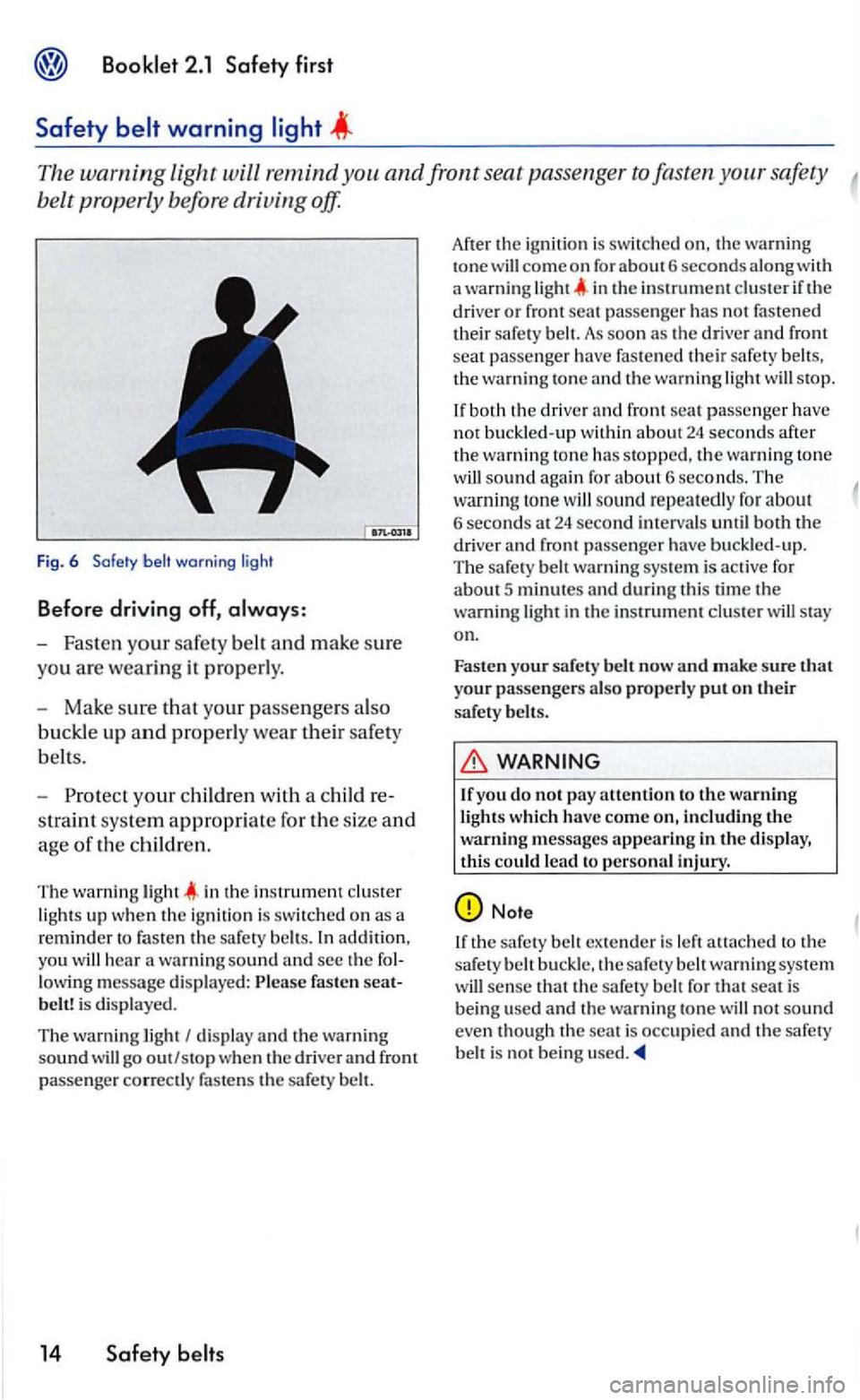
The warning Light will remind safety
belt prop erly before driving off.
Fig . 6 Safety warn in g l ig ht
Before driving off,
-Fast en your safety belt and make sure
you are wea ring it properly.
- Mak e sure that your passengers als o
buckle
up and properly wear their safety
b elts.
- Pro tec t yo
ur children with a child re
s traint sys
tem appropria te for the size and
age of th e children.
T he wa rnin g in the in strument lights up w he n the ig niti on is switched o n as a
reminder to fasten th e safety addition,
yo u
14 Safety
Afte r the ig nition is swit ch ed th e warning tone come on for about6 second s along with warning light in the in strument if th e drive r or front seat passe nge r has not fastened their safet y bel t. As soon as the driver and front seat passe nger have fastened their safety the wa rnin g ton e and the warning light stop .
sound aga in for about 6 second s. The
ton e w ill sound repeatedly for about 6 seconds 24 second interva ls until both drive r and front passenger have buckled-up .
T he safety wa rnin g system is active for about 5 minutes and during thi s time the warni ng light in the instrument clus te r wiU stay
on.
Fa s
ten your safe ty belt now and make sure t hat your passengers also properly put o n their
safery belts.
WARNING
If yo u do not pay attenti on to the warning
li ghts whic h h ave come including the warning messages appearing in the display, this could lead to pe rsonal injury.
ex tender is left attac h ed to the
s afery warning sys tem will sense th at th e safe ty n o t sound even though th e is occ upie d and the safery
Page 106 of 444
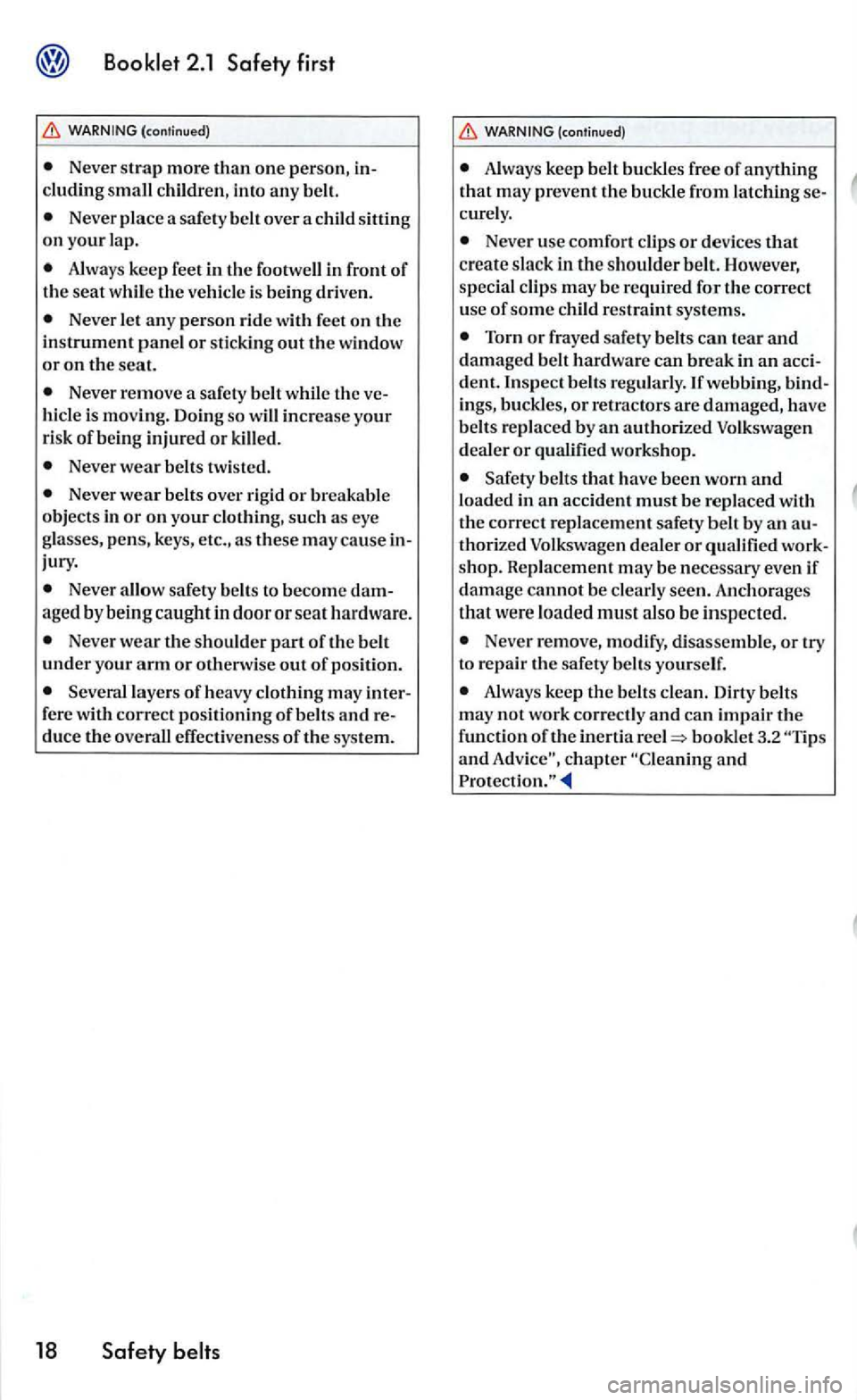
2.1 Safety first
Never strap more than one person, in
cluding c hildren, into any belt.
Never place a safety belt over a child sittin g on your lap.
• Always keep feet in
the footwell in front of the seat while the vehicle is being driven.
Never let any person ride with feet on the instrument panel or sticking out the window or on the seat.
Never remove a safety belt while the ve
hicle is moving. Doing so will increase your
risk of being injured or killed.
Never wear belt s twisted.
Never wear belt s over rigid or breakable
objects in or on your clothing, such as eye
glasses, pens, keys, etc., as these may cause injury.
Never allow safety belts to become damaged by being caught in door or seat hardware.
Never wear the shoulder part of the belt under your arm or othenvise out of position.
Several layers of heavy clothing may inter
fere with correc t positioni11g of belts and reduce the overall effectiveness of the sys tem.
18 Safety
(continu ed)
Always keep belt buckles free of anything
that may preven t the buckle from latch ing se
cure ly.
Neve r use comfort clips or devices that create slack in the sh oulder belt. However,
specia l clips may be required for the correct
use of some c hild restraint systems.
Torn or frayed safety belts can tear and damaged belt hardware can break in an accident.lnspect belts regularly. If webbing, bind
ings, buckles, or retractors are damaged, have
be lts replaced by an authorized Volkswagen
dealer or qualified workshop.
Safety belts that have been worn and loaded in an accident must be replaced with the correc t rep lacement safety belt by an authorized Volkswagen dealer or qualified work
s h op. Replacement may be necessary even if damage cannot be clearly seen. Anchorag es
that were loaded must a lso be inspected.
Never remove, modify, disassem ble, or try
to repair the safety belts yourself.
Alwa ys keep the belts clean. Dirty belts
may not work correct ly and can impair t11e func tion of inertia reel booklet 3.2 and
Page 107 of 444
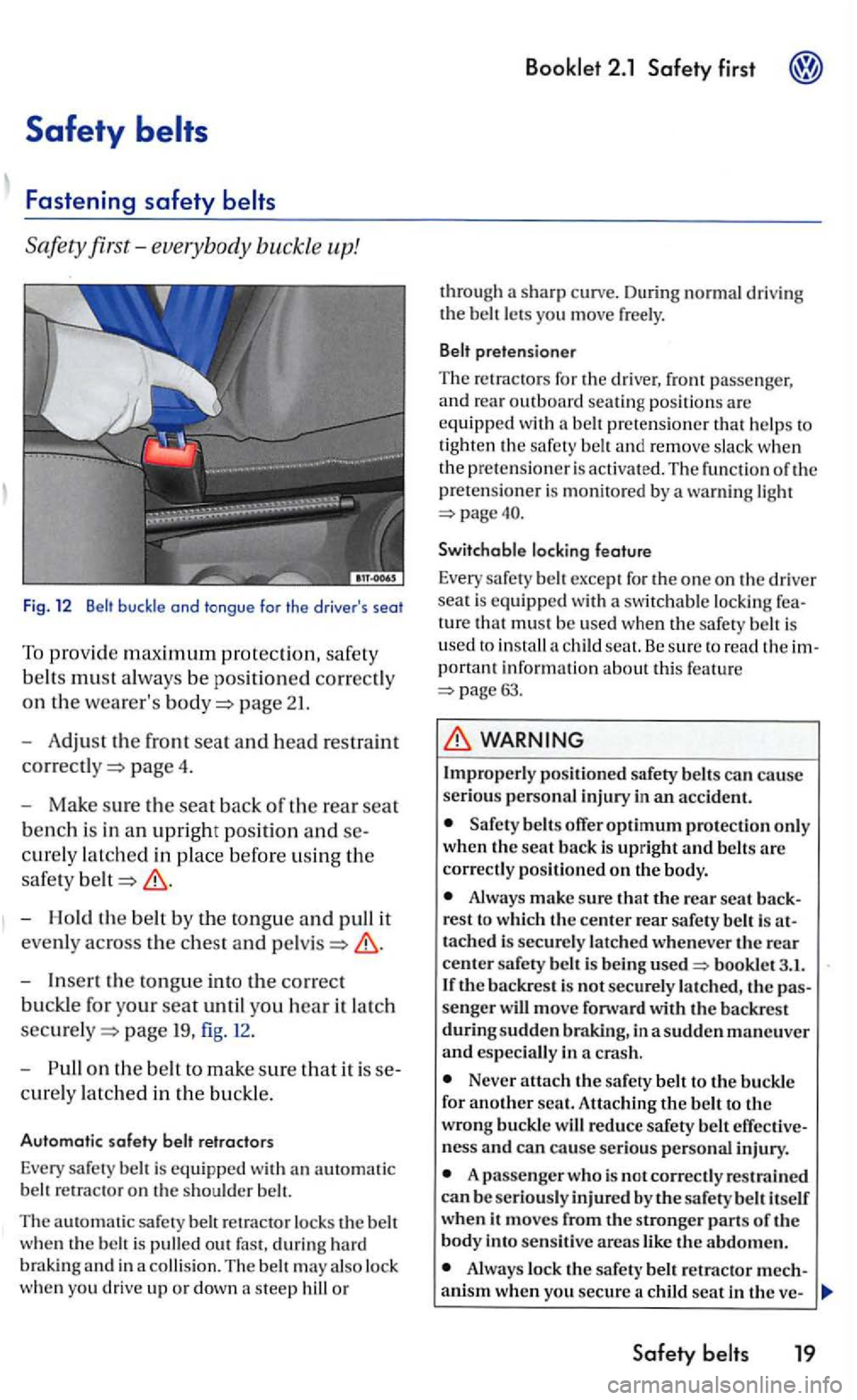
Safety
Safety first-everybody buckle up!
Fig. 12
page 2 1.
- A
djus t the front seat and head restra int
page 4.
-
Make sure the seat back of the rear seat
bench is in an upright position and
cure ly latched in place before using the
safe ty
belt
- Hold the belt b y the to ngue and pull it
eve
nly across the chest and
page 19, fig . 1 2.
-
o n th e belt to make sure that it is se
c u re ly latched in the buckl e.
Automatic safe ty belt retractors
Every safe ly is equi ppe d an o n he s houlder b ell.
The
s a fe ly belt r etrac tor lock s th e belt
w he n the belt is pulled out fast, durin g ha rd
brak ing and in a collision. The ma y also lock when you drive u p or d own a steep hill or
Booklet 2.1
through a sharp curv e. During normal drivin g
the
for the d river, fron t passenge r,
a nd rear out bo ard seating po sition s are equipped wit h a prete n sioner that h elp s to tig h ten the sa fe ty and remove slack w hen
th e pr ete n sioner is act iva te d. Th e functi on of th e
p retension er is monito re d b y a warning light
Switchable lockin g feature
Every safety exce pt for th e one on th e dri ver seat is equipped w ith a switchabl e lock ing ture that mus t be u se d w hen the sa fety is u se d to install a c hild seal. Be sure to read he portant informa tio n abou t thi s fea tur e page63.
WARNING
Improperly posi tion ed safety
offe r optimum protec tion only when the seat back is upright and belts are correctl y po sition ed on the body.
Alwa ys make sure that the rear seat back
r es t to whi ch th e center rear safety is at
tach ed is secu re ly latched whenever th e re ar
cente r safe ty belt is being used bookl et 3.1. If the bac kres t is not s ecurely la tc hed , the passenger wiU move forward with the backre st durin g sudden braking, in a sudden maneuver
and e specially in a cra sh .
Never att ac h the safet y belt to the buckle
for another scat. Atta chin g the belt to the wrong buckle w ill re du ce safety belt ness and can ca use serious perso nal injury.
A passenger who is not correctl y res tra ined can be se riou sly injured by the sa fety belt itself
w hen it moves from th e stronger parts of the body int o sensit ive areas like the abdomen.
Alwa ys lock th e safe ty belt re tra ctor m echanism when yo u secure a child seat in th e ve-
Safety belts 19
Page 111 of 444
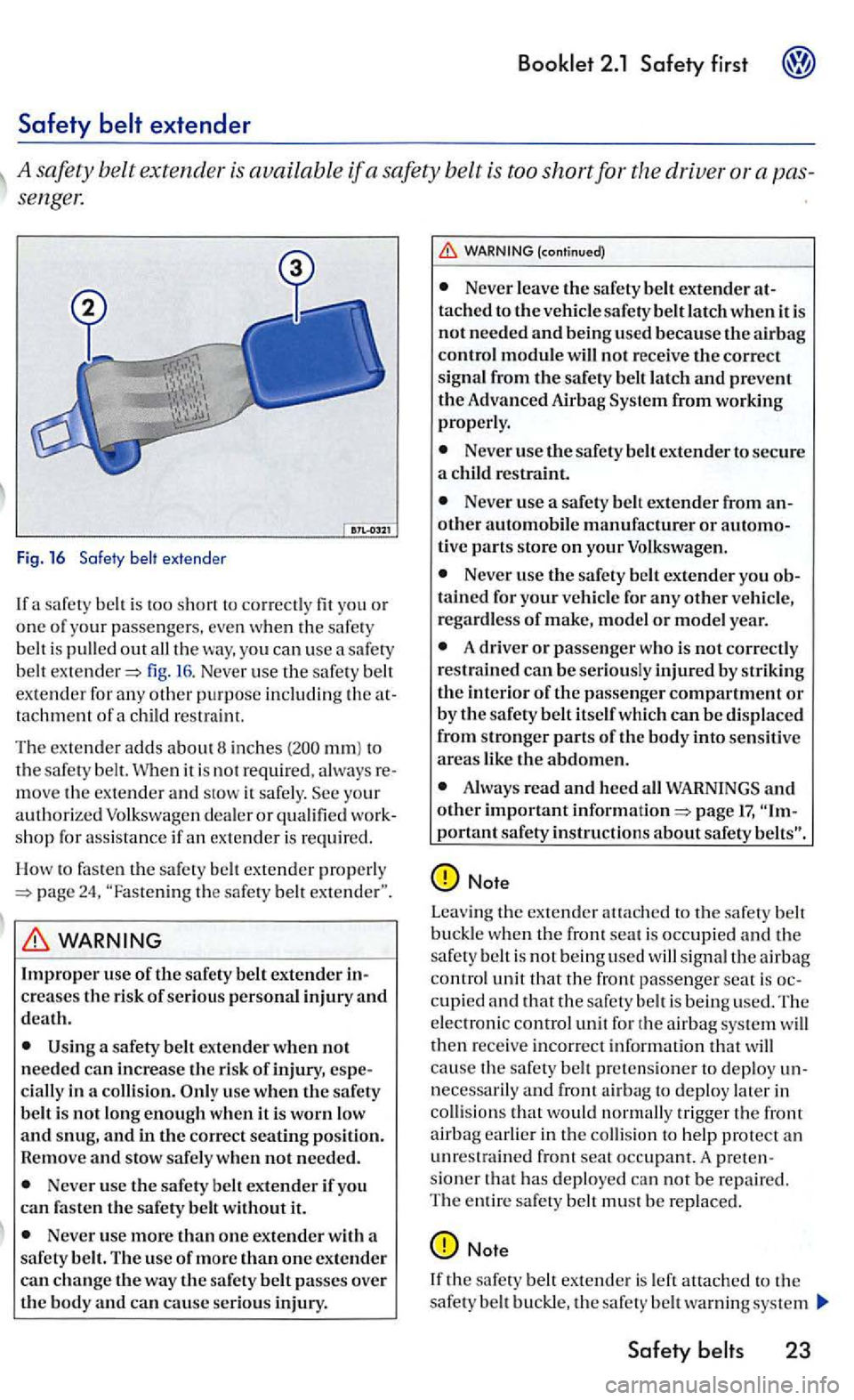
Safety
sengel:
Fig. 16 Safe ty
out fig . 16 . Never use th e safe ty belt
ex tende r for any oth er purpo se includin g th e tachment of a c hild restraint.
Th e
exte nder adds a boutB inches mm) to
the safery belt. Whe n it is not require d , always
s hop for a ss is tan ce if an extende r is requ ired .
H ow to fas te n the s
afety belt extender properly 24, th e sa fe ty belt
crea ses the risk of seriou s personal injury and death.
a safery belt exten de r w hen not needed can increase the risk of injury , cially in a collision. it is worn low
and snug, and in the cor rec t seating position.
R emove and sto w safe ly when not needed.
Never use the safet y belt extender if yo u
ca n fasten the sa fety belt without it.
Never use more than one extender with a
safery be lt. The use of m ore than one extender c a n ch ang e the way the sa fe ty belt passes over
the body and can cause se rious injury .
Never leave the saferybelt extender ta ched to the veh icle safe ty belt latch when it is not needed and being used because th e airbag control module will not re ceive the correc t
s ign al from the safety b elt la tc h and prevent the Advanc ed Airbag from working properly .
Never use the safe ty belt extender to secure
a child restraint.
Never use a safery belt ex tender from
Nev er u se the safery belt extend er yo u tained for your vehicle for any other vehicle,
regardless of make, model or model year.
A driver or pass enger w ho is not correct ly
re strained can be seriously injured b y striki ng the interior of the passe ng er compartment or by the safery b elt its elf whi ch can b e di spla ced
from stronger parts of the body into se nsiti ve areas lik e th e abdomen.
Always read and heed all WARNINGS and other important pa ge
signal th e airbag
co ntrol unit that the front passenge r seat is
ca use the s afery belt prete nsio n er to deploy necessarily and fron t to deplo y la ter in
collision s th at would trigge r the front
a irb ag earlie r in th e to help pro tect an unrestrain ed front seat occ upant. A sioner that has dep loyed can not b e repair ed.
T he entire sa fety belt mu st b e rep laced.
Safety
Page 116 of 444
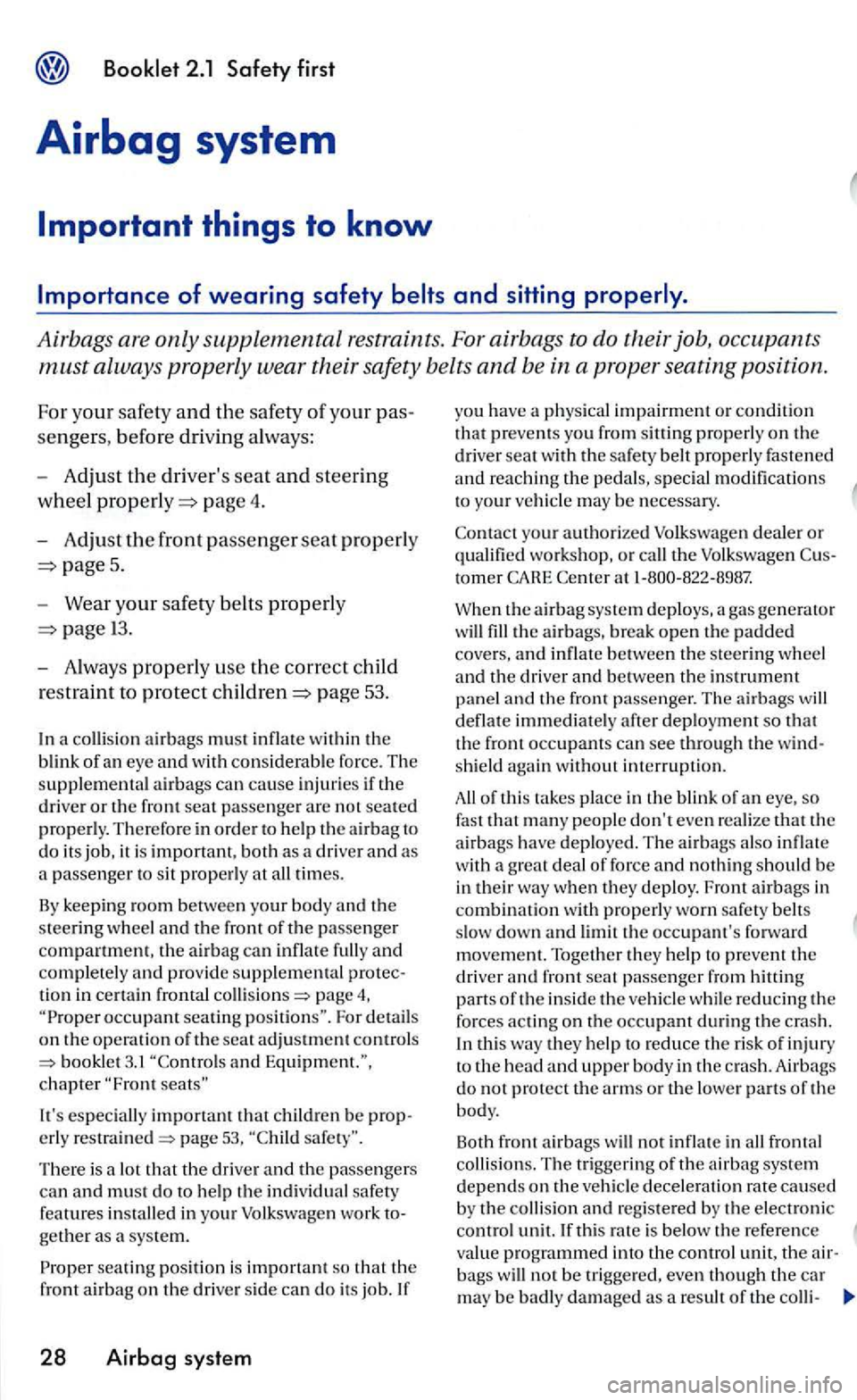
2.1 Safety first
Airbag system
Important things to know
Airbags are only supplemental re straint s. For airbags to do their job,
sen gers, befor e dri vin g a lw ay s:
- Adju st th e driver' s
seat and steering
w heel
5.
- Wear y
our safety be lt s properly
13.
- Always properly use the correct child
re straint
to protect page 53.
a co llisio n airbags mu st
times.
keep in g roo m be tween your bo d y and the
s teerin g w heel and the front of the passe nge r the ai rb ag can and completely and pro vid e supplemental page 4, occupant seatin g For details on th e o perati on of the seat adju stment control s and
important th at page 53,
There is a tha t the dri ver and th e passengers can and must d o t o h elp the individual safe ty feature s work
seating position is important so that the fron t airb ag on the drive r sid e c an do its job.
28 Airbag system
you h ave a physical impairment o r condition that prevents you from sitti ng properly on the
driver seat w ith the safe ty
may be necessary .
your au th o rize d dealer or qualified workshop, or the to mer
When the ai rbag syste m deploys, a gas generato r the ai rbags. brea k ope n the padded cove rs, and
shie ld again without interruptio n.
o f thi s tak es place in the of a n eye, so fast th at many people don 'teven realize that the airbags ha ve deplo yed. The airb ags also
reducing th e forces actin g o n the occupant d ur in g t he crash . th is way th ey help to re duce the ris k of in ju ry
t o the head and uppe r bo dy in t he cra s h. Airbags
d o not protect the arms or the lowe r parts of th e
body.
Both f ront a irb ags no t fro nta l
collisio ns. The tr igger ing o f the airbag sys te m
d epend s o n the an d re gis te re d by the electronic
contro l unit.
b ags
Page 117 of 444
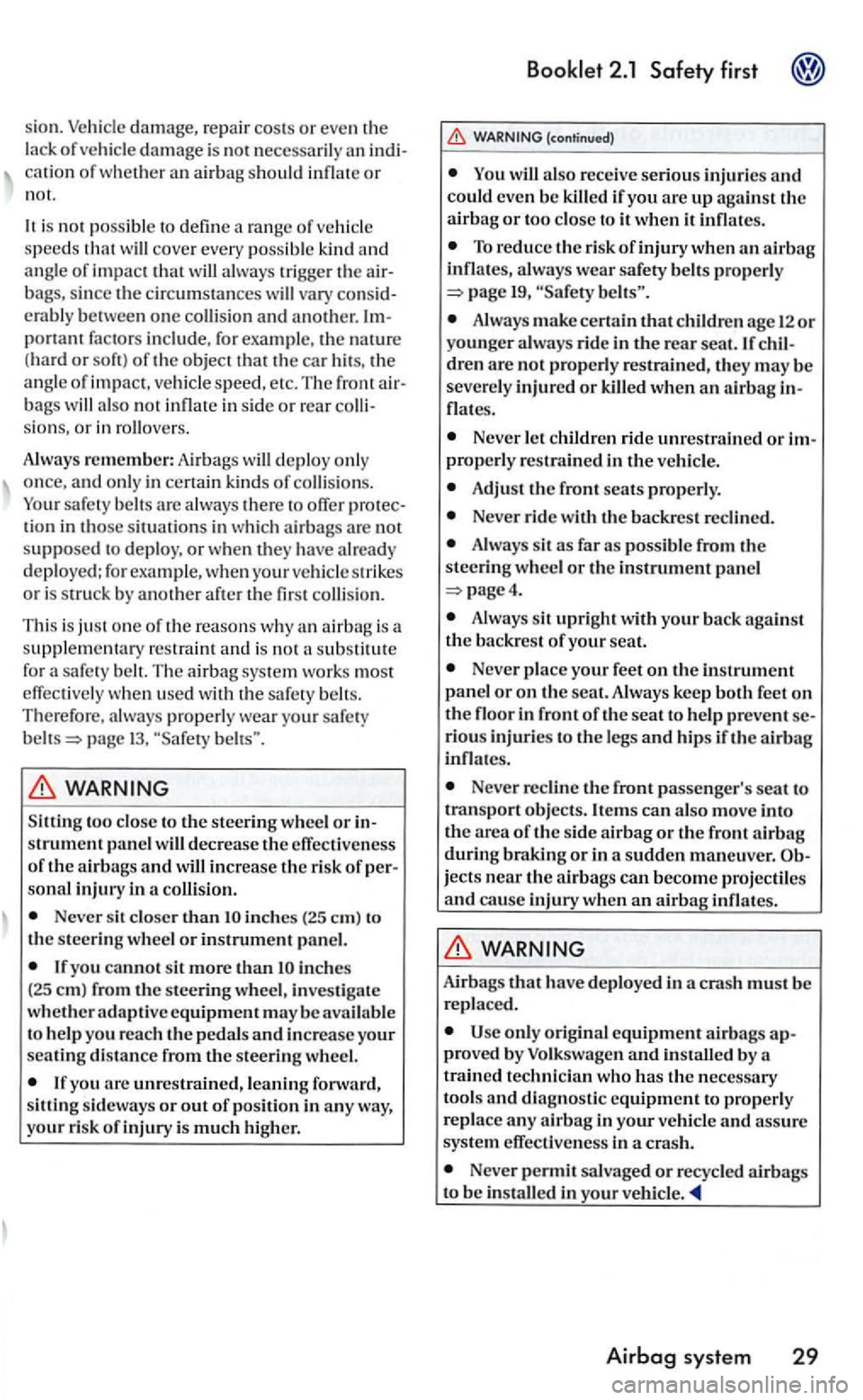
sion. d am age, repair co sts or eve n the
l ack of damage is no t an of w het her an airb ag s ho uld o r
not.
i s no t po ssible to define cove r every poss ibl e kind and an g le of impact that alway s tri gge r th e bags , s ince th e c ircumstan ces vary era b ly be tw ee n one po rt ant factors include , for examp le, the natur e
( hard or so ft) of th e objec t that the ca r hi ts, th e
angle of imp act, vehicle speed, etc. The front bag s als o no t in side or rear sio ns, orin rollove rs .
Always re m em ber: Airb ags
depl oy only
once, and only in certain kinds of collisions. safety b elts are always th ere to tion in th o se situ ations in w hi ch airb ags are not supposed t o dep loy . o r when they have already
d eployed; for exa mpl e, wh en yo ur
sub stitut e for safe ty bel t. The airba g syste m wor ks mo st
effectivel y w he n u sed with the sa fety belts. Therefore , always properly wear your sa fety
WARNING
S itting too clo se to the stee rin g wheel or strument pa n el will decrease the effec tiv en ess of the airbags and will increase the risk of sonal injury in a co llision.
Ne ver sit clo se r than in ch es (25 em ) to th e steering wheel or instrument panel.
If you cannot sit more than
first
(continued)
to it when it
To redu ce the risk of injury when an airbag inflates, always wear safety belts properly 19,
Always make certain that children age 12 or younge r always rid e in the rear seat. If dren are not properly restrained, they may be sever ely injured or killed when an airb ag flat es.
Never le t childr en ride unrestrained or
Adju st the front seats properly.
Never rid e w ith the backr est
Always sit as far as poss ible from the steerin g whee l or the instrument panel
Alway s sit upright with your back against the backrest of your seat.
Neve r place your feet on the in strument panel or on th e seat . Always keep both feet on the in front of the seat to help preven t rio us in juri es to the legs and hip s if the a irbag
infl ates.
Never reclin e the front passenger 's seat to transport objects. Item s can also move into the area of th e s ide alrbag or the front airbag during braking or in a sudden maneuver. jects b eco me projectiles and caus e injury when an airbag infl ates.
WARNING
Airbags that have deplo yed in a cra sh mus t b e replaced .
onl y o riginal equipment airbags proved by Volkswagen and Installed by a
trained technician who has th e necessary tool s and diagnostic equipment to properly replace any airbag in your
Never permit salvage d or recycled airba gs
to be installed in your vehic le.
Airbag system 29
Page 118 of 444
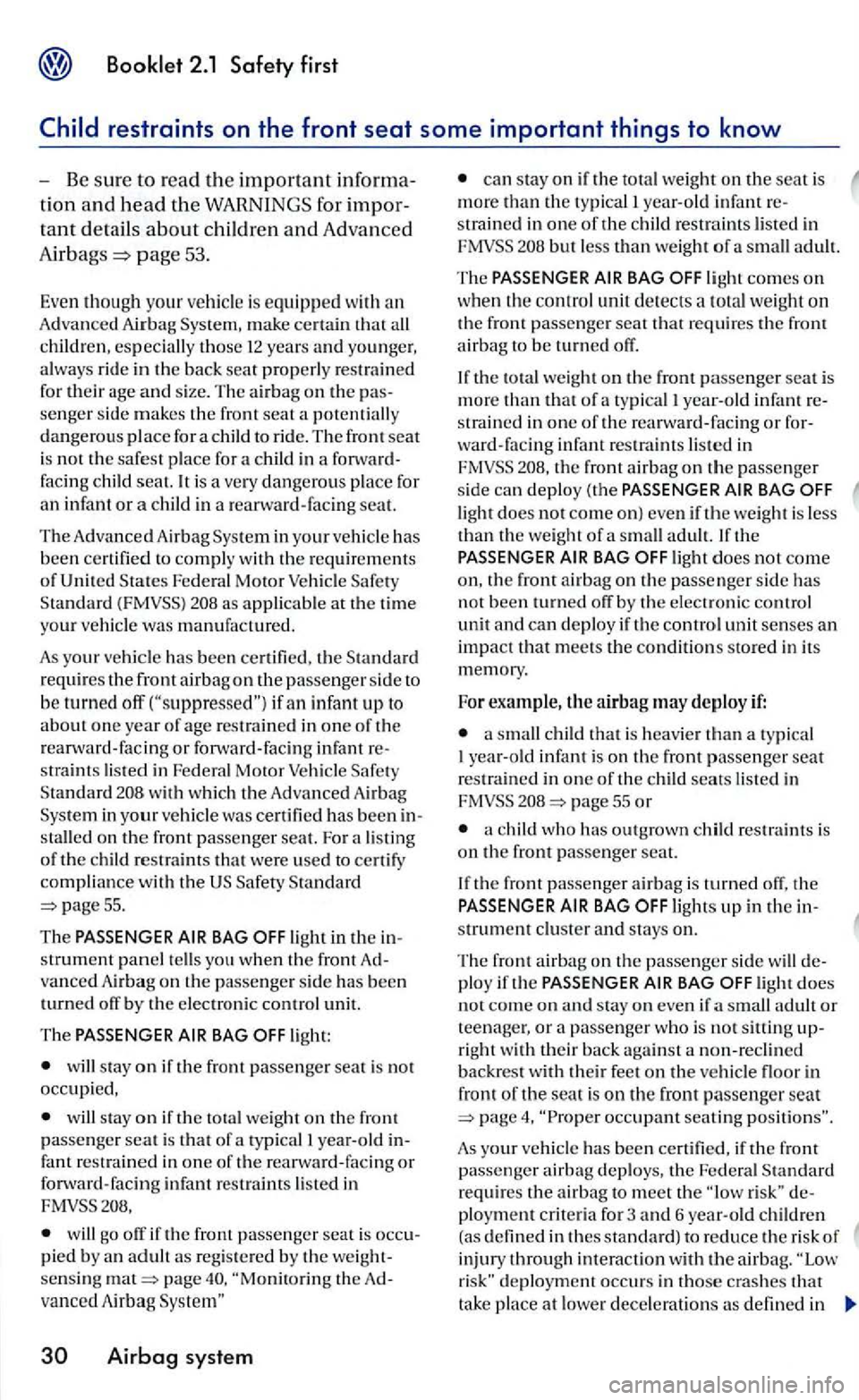
page 53.
Eve n though your vehicl e is equipped wit h an Advanced Airbag System, make certain that all childre n , especially those 12 years and younger, a lways ride in the back seat properly restrained for their
if an infant up to about one year of age restrained in on e of the rearward-fac ing or forward-facing infant re
straints lis ted in Federal Mo tor Standard 208 with which the Advanced Airbag Sys te m in your was certified has been installed on the front passenger seat. For a listing of the child restraints that were used certify compli ance with the
55.
The PASSENGER
will stay on if the front passenger seat is not occupied,
will stay o n if the tot al weight o n the front passenger seat is that of a typical year-o ld infant restrain ed in one of th e rearward-facing or forward-fa cing infant restraints listed in
w ill go off if the front passenger seat is occupied by a n adult as re gis te red by the weightsen sin g page 40,
can stay on if the weight on the seat is more than th e typical! year-o ld infant re-
strained i n one of the child restraints li sted in 208 but less than weigh t of a small
the total weigh t on the front passenger seat is more tha n that of a typica l
208, the front airbag on the passenger side can deploy (the PASSENGER
light does not come on) even if the weight is less than the weight of a small adult. I f the PASSENGER light does not come o n, th e front airbag o n the passenger side has not been turned off by th e e lectronic control unit and can deploy if the control unit senses an impact that meets the conditions stored in its
memory.
For example, the airbag may deploy if:
a small chil d that is heavie r than a typical year-old infant is on the front passenger seat restrained in one of the c hild seats liste d in 20 8 page 55 or
a child who has outgrown child restraints is on the front passenger seat.
If the front passenger airbag is turned off, the PASSENGER and sta ys on.
The front airbag on the passenger sid e w ill deplo y if the PASSENGER BAG lig ht does not come on and sta y on even if a small or teenager, or passenger who is not sitting up
right w ith their back against a non-recl in ed bac kre st with th eir feet on the in
front of the seat i s on the
deployment occurs in those crashes that ta ke place at lowe r decelera ti o ns as defined in
Page 119 of 444
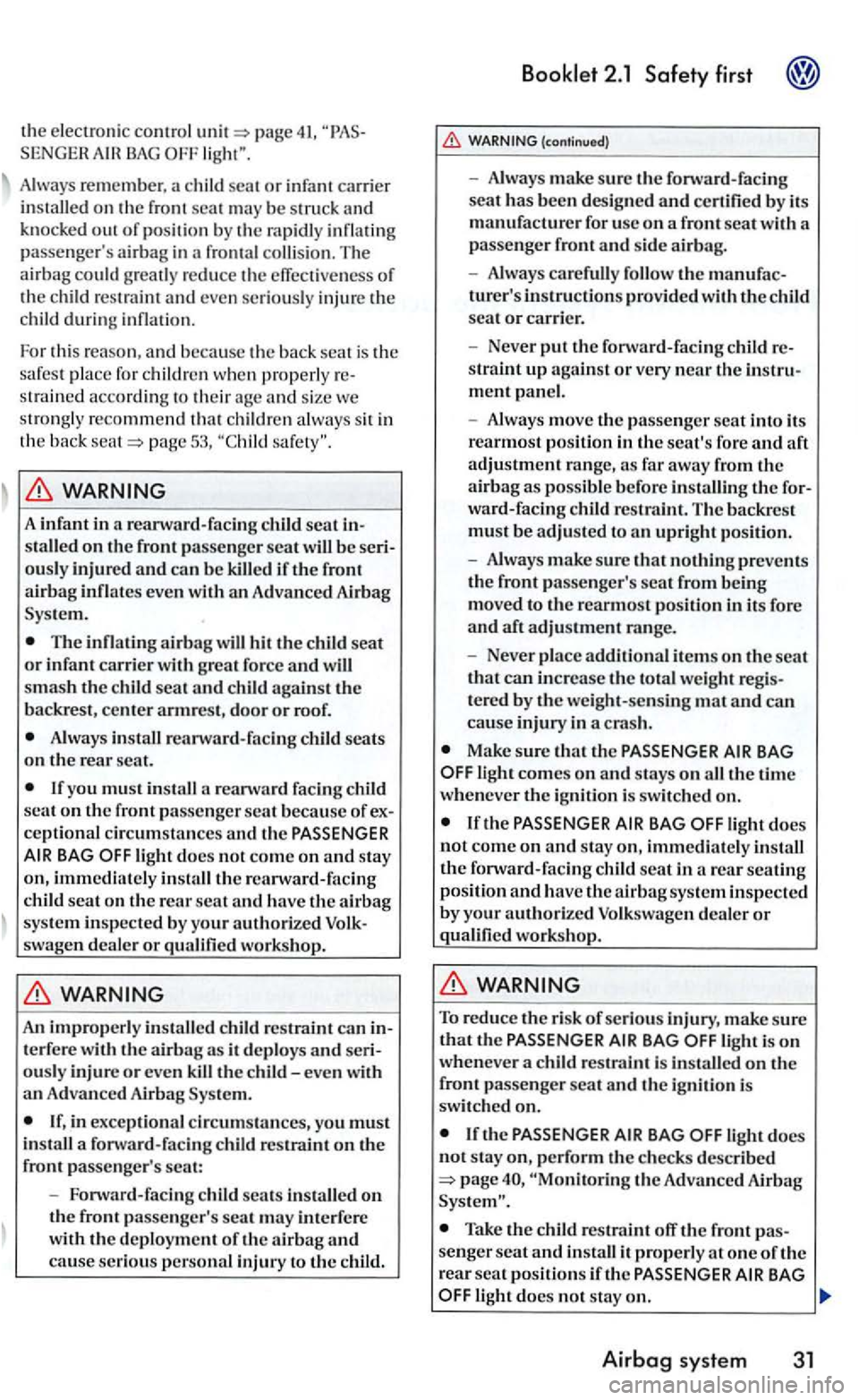
the elec tronic control page 41, SENGER
Always remember. a child seat or infa nt carrier
in stalled on th e fron t seat may the rapidly pas senger's airbag in a frontal collision. The
airbag could greatly re duce the effectiveness of the c hild restraint and even seriou sly injure th e
c hild during
stro ng ly recommend that children always sit in
th e back page 53,
infant in a seat stall ed on th e front passe nge r seat ously injured and can be killed if the front
airbag inflates eve n with an
System.
The inflating airba g will hit the child seat or infant carrier with great force and will
smas h th e c hild seat and c hild against the backrest, cent e r armre st, door or roof.
Always install r earwa rd-facing child seats on the rear scat.
If you must install a rearward facing child seat on the front passe nger scat becau se of
light docs not com e on and stay on, imme diatel y
your authorized swage n dealer or qualified workshop.
terferc with the ously inju re or even the child -eve n with
a n A irb ag
in exceptio nal circumstances, you must
in stall a fonvard-facing c hild restraint on the front passe nger's sca t:
-
Fon vard-facin g seats install ed on the front passenger's seat may interfer e
with the deplo ym ent of the air bag and cause seriou s personal injury to the child .
2.1 Safety first
turer's instructions provid ed with the c hild
sea t or carrier.
- Neve r
put the fonvard-faci ng c hild
ment panel.
- Always move the passe nge r sca t into its
rearmost pos ition in the scat's fore and aft adjustment range, as far away from the airbag as possi ble before installing ward-facing
scat that can increase the total weight te re d by the weig ht-sensing mat and ca n
ca use injury in a cras h.
Make sure that the BAG light comes on and stays on all the time w henever the igniti on i s switc hed on.
th e BAG light does not com e on and stay on , imm ediately in stall the fonv ard-facing child scat in a rea r seatin g
position and have the airba g sys tem inspec ted
by your authorized Volkswagen dealer or qualified workshop.
To reduce the ris k of se rious injury, make su re that tltc light is on whenever a child restraint is install ed on th e
front passenger scat and the ig niti on is switched on.
the d ocs not stay on, perform th e c hecks descr ibed the Advanc ed
Take the c hild restra int off the front senger seat and in stall it properly at one of the
r ear sea t position s if th e BAG light does not sta y on.
Airbag system 31
Page 120 of 444
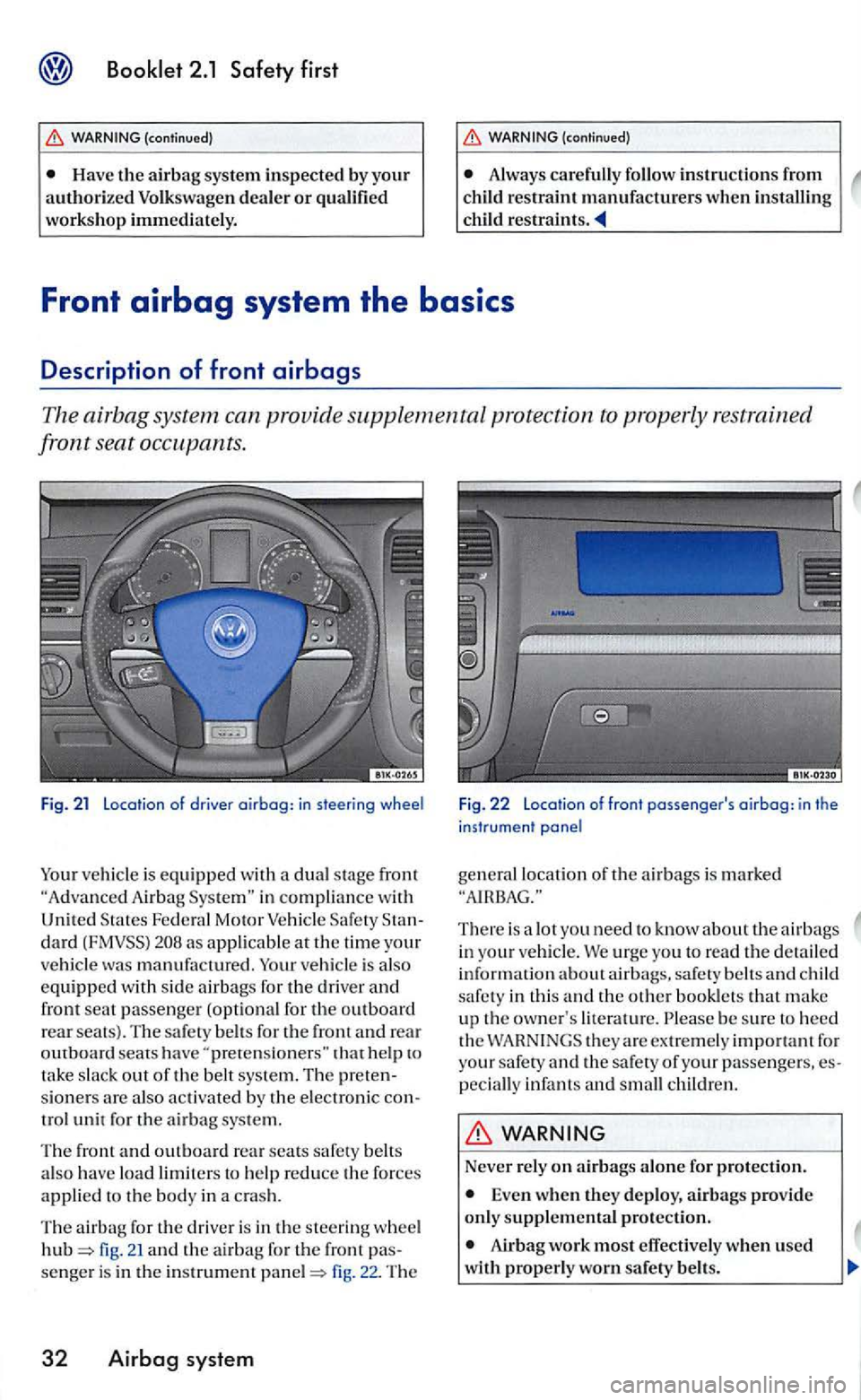
Have th e a irbag system inspected by you r authorize d Volkswagen deale r or qualified
workshop immediately. Always carefully follow instructions from
Fig. 21 Location of driver airbag: in steering wheel
ve hicl e is equipped with a dual s tage front A ir bag in compliance w ith
Unit ed Fede ra l Motor Veh icle dard as applicable at th e time your ve hicl e was manufa ctured . vehi cle is also equipped w ith sid e airbags for the driver and fron t se at passenge r (opt io nal for the outboard re a r seats). The sa fety belts for th e front and re a r outboard seats have ''pretensioners"
fig. 21 and th e ai rbag for the front fig. 22. The
32 Airbag system
F ig. 22 Location of front passenger's airbag: in the
instrument panel
gen era l lo ca tion of the a irba gs is marked
There is a lot you need to know about th e airbags in yo ur veh icle . We urg e you to read the detailed
information abo ut airb ags. safety belts and child
safe ty in thi s and the o th er bookle ts th at m ake
up the own er' s literature. be sur e to heed
th e th ey are extrem ely important for
your safet y and t h e s afety of yo ur passe nge rs, pecially infan ts and small c hildr en.
WARNING
Never rely on airb ags alone for protect ion.
Even when they deplo y, airbags provide only supplem ental protection.
Airbag work most effective ly w he n used
with properl y worn safet y belts.